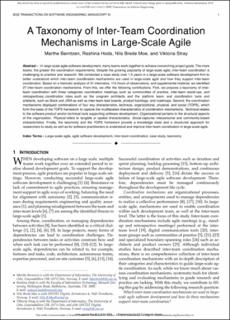| dc.description.abstract | In large-scale agile software development, many teams work together to achieve overarching project goals. The more teams, the greater the coordination requirements. Despite the growing popularity of large-scale agile, inter-team coordination is challenging to practice and research. We conducted a case study over 1.5 years in a large-scale software development firm to better understand which inter-team coordination mechanisms are used in large-scale agile and how they support inter-team coordination. Based on a thematic analysis of 31 interviews, 113 hours of observations, and supplemental material, we identified 27 inter-team coordination mechanisms. From this, we offer the following contributions. First, we propose a taxonomy of inter-team coordination with three categories: coordination meetings, such as communities of practice, inter-team stand-ups, and retrospectives; coordination roles, such as the program architects and the platform team; and coordination tools and artefacts, such as Slack and JIRA as well as inter-team task boards, product backlogs, and roadmaps. Second, the coordination mechanisms displayed combinations of four key characteristics, technical, organizational, physical, and social (TOPS), which form the basis of the TOPS framework to capture the multifaceted characteristics of coordination mechanisms. Technical relates to the software product and/or technical tools supporting software development. Organizational pertains to the structural aspects of the organization. Physical refers to tangible or spatial characteristics. Social captures interpersonal and community-based characteristics. Finally, the taxonomy and the TOPS framework provide a knowledge base and a structured approach for researchers to study as well as for software practitioners to understand and improve inter-team coordination in large-scale agile. | en_US |

